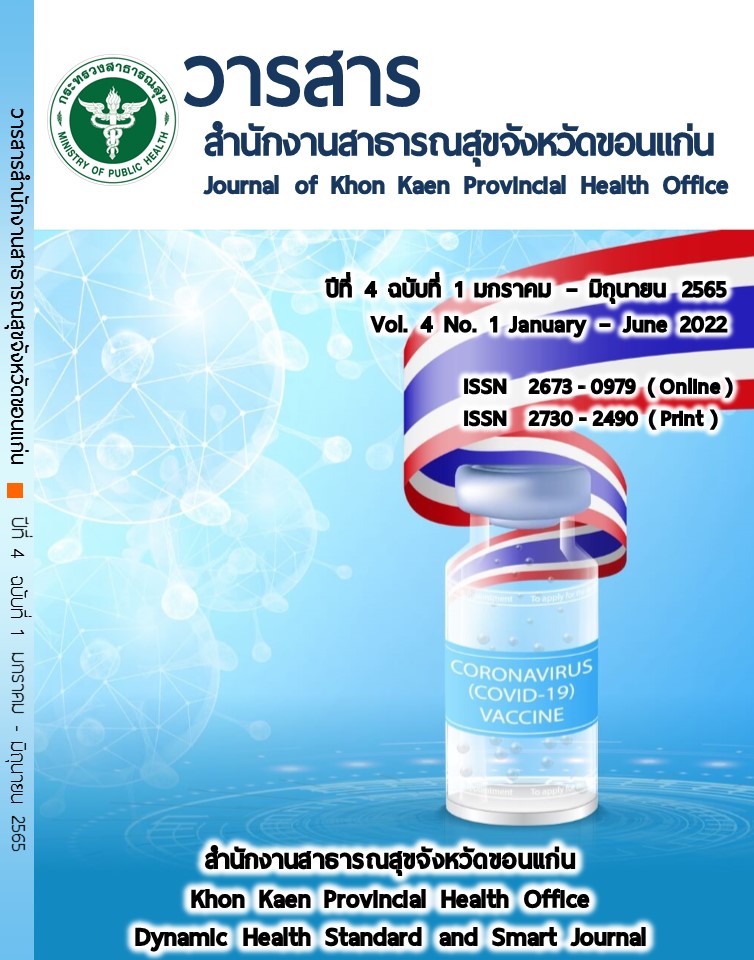ปัจจัยทำนายการตอบสนองต่อยาเคมีบำบัดสูตรแรกในผู้ป่วย ที่เป็นมะเร็งท่อน้ำดีชนิดลุกลาม
คำสำคัญ:
มะเร็งท่อน้ำดี, เคมีบำบัด, ปัจจัยทำนายบทคัดย่อ
มะเร็งท่อน้ำดี พบมากอันดับ 1 ของภาคตะวันออกเฉียงเหนือ และเป็นสาเหตุการเสียชีวิต ที่สำคัญ มีการศึกษาปัจจัยทำนายการตอบสนองต่อการให้ยาเคมีบำบัด เช่น gene expression แต่ไม่สามารถตรวจได้ใน รพ.ทั่วไป การวิจัยนี้มีวัตถุประสงค์เพื่อศึกษาปัจจัยทำนายการตอบสนองต่อการให้ยาเคมีบำบัดสูตรแรกในผู้ป่วยมะเร็งท่อน้ำดีระยะลุกลามที่สามารถตรวจได้และปัจจัยทำนายโรคที่ส่งผลต่อระยะเวลาที่ควบคุมโรคได้ (Progression-free survival) โดยเป็นการศึกษาย้อนหลังเชิงวิเคราะห์ เก็บข้อมูลจากเวชระเบียนผู้ป่วยมะเร็งท่อน้ำดีระยะลุกลาม หรือระยะกระจาย ที่ได้รับยาเคมีบำบัดตั้งแต่ 2559 - 2564 ใช้สถิติเชิงพรรณนา (Descriptive statistics) และวิเคราะห์ข้อมูลโดยใช้ Pearson’s chi square, exact probability, univariate and multivariate analyses, Cox’s proportional hazard analysis และ Kaplan-Meier method โดยผลการศึกษาพบว่าผู้ป่วยมะเร็ง ท่อน้ำดีจำนวน 56 ราย อายุเฉลี่ย 61.3 ปี เป็น intrahepatic ร้อยละ 73.2 เป็นระยะกระจาย ร้อยละ 80.4 ส่วนมากกระจายไปต่อมน้ำเหลืองในช่องท้อง (ร้อยละ 33.3) และตับ (ร้อยละ 22.7) มีการตอบสนองต่อยาเคมีบำบัดร้อยละ 55.4 ค่ามัธยฐานระยะเวลาที่ควบคุมโรคได้ (median PFS) 6.5 เดือน เมื่อวิเคราะห์ปัจจัยพยากรณ์ต่างๆ ในกลุ่มที่ตอบสนองต่อยาเคมีบำบัดเทียบกับ กลุ่มไม่ตอบสนองพบว่าไม่แตกต่างกัน ปัจจัยที่ส่งผลต่อระยะเวลาที่ควบคุมโรคได้ (PFS) ได้แก่ ALT (p-value 0.016), CA19-9 (p-value 0.033) และ platelet lymphocyte ratio (p-value 0.032) เมื่อทำ multivariate analysis พบว่าปัจจัยที่มีนัยสำคัญ ได้แก่ CA19-9 (P-value 0.048) จาก ผลการศึกษาไม่พบปัจจัยที่สามารถใช้ทำนายการตอบสนองต่อยาเคมีบำบัด อย่างไรก็ตามปัจจัย การพยากรณ์โรคที่ส่งผลต่อระยะเวลาควบคุมโรคที่มีนัยสำคัญ ได้แก่ CA19-9
เอกสารอ้างอิง
Kamsa-Ard S, Santong C, Kamsa-Ard S, Luvira V, Luvira V, Suwanrungruang K, et al. Decreasing trends in cholangiocarcinoma incidence and relative survival in Khon Kaen, Thailand: An updated, inclusive, population-based cancer registry analysis for 1989-2018. PLoS One. 2021; 16(2): e0246490.
Namjan A, Techasen A, Loilome W, Sa-Ngaimwibool P, Jusakul A. ARID1A alterations and their clinical significance in cholangiocarcinoma. PeerJ. 2020; 8: e10464.
Pattanathien P, Khuntikeo N, Promthet S, Kamsa-Ard S. Survival rate of extrahepatic cholangiocarcinoma patients after surgical treatment in Thailand. Asian Pac J Cancer Prev. 2013; 14(1): 321-4.
Sriputtha S, Khuntikeo N, Promthet S, Kamsa-Ard S. Survival rate of intrahepatic cholangiocarcinoma patients after surgical treatment in Thailand. Asian Pac J Cancer Prev. 2013; 14(2): 1107-10.
Woradet S, Promthet S, Songserm N, Parkin DM. Factors affecting survival time of cholangiocarcinoma patients: a prospective study in Northeast Thailand. Asian Pac J Cancer Prev. 2013; 14(3): 1623-7.
Valle J, Wasan H, Palmer DH, Cunningham D, Anthoney A, Maraveyas A, et al. Cisplatin plus Gemcitabine versus Gemcitabine for Biliary Tract Cancer. New England Journal of Medicine. 2010; 362(14): 1273-81.
Templeton AJ, McNamara MG, Šeruga B, Vera-Badillo FE, Aneja P, Ocaña A, et al. Prognostic Role of Neutrophil-to-Lymphocyte Ratio in Solid Tumors: A Systematic Review and Meta-Analysis. JNCI: Journal of the National Cancer Institute. 2014; 106(6).
Zhou D, Zhang Y, Xu L, Zhou Z, Huang J, Chen M. A monocyte/granulocyte to lymphocyte ratio predicts survival in patients with hepatocellular carcinoma. Sci Rep-Uk. 2015; 5: 15263.
Wu C-E, Chou W-C, Hsieh C-H, Chang JW-C, Lin C-Y, Yeh C-N, et al. Prognostic and predictive factors for Taiwanese patients with advanced biliary tract cancer undergoing frontline chemotherapy with gemcitabine and cisplatin: a real-world experience. BMC Cancer. 2020; 20(1): 422.
Hu G, Liu Q, Ma JY, Liu CY. Prognostic Significance of Platelet-to-Lymphocyte Ratio in Cholangiocarcinoma: A Meta-Analysis. Biomed Res Int. 2018; 2018: 7375169.
Huh G, Ryu JK, Chun JW, Kim JS, Park N, Cho IR, et al. High platelet-to-lymphocyte ratio is associated with poor prognosis in patients with unresectable intrahepatic cholangiocarcinoma receiving gemcitabine plus cisplatin. BMC Cancer. 2020; 20(1): 907.
Hahn F, Müller L, Jungmann F, Mähringer-Kunz A, Tanyildizi Y, Düber C, et al. Survival prediction for patients with non-resectable intrahepatic cholangiocarcinoma undergoing chemotherapy: a retrospective analysis comparing the tumor marker CA 19-9 with cross-sectional imaging. J Cancer Res Clin. 2020; 146(7): 1883-90.
Lee BS, Lee SH, Son JH, Jang DK, Chung KH, Paik WH, et al. Prognostic value of CA 19-9 kinetics during gemcitabine-based chemotherapy in patients with advanced cholangiocarcinoma. J Gastroenterol Hepatol. 2016; 31(2): 493-500.
Lee BS, Lee SH, Son JH, Jang DK, Chung KH, Paik WH, et al. Prognostic value of CA 19-9 kinetics during gemcitabine-based chemotherapy in patients with advanced cholangiocarcinoma. J Gastroen Hepatol. 2016; 31(2): 493-500.
Grunnet M, Christensen IJ, Lassen U, Jensen LH, Lydolph M, Knox JJ, et al. Decline in CA19-9 during chemotherapy predicts survival in four independent cohorts of patients with inoperable bile duct cancer. European Journal of Cancer. 2015; 51(11): 1381-8.
Lee D-W, Im S-A, Kim YJ, Yang Y, Rhee J, Na II, et al. CA19-9 or CEA Decline after the First Cycle of Treatment Predicts Survival in Advanced Biliary Tract Cancer Patients Treated with S-1 and Cisplatin Chemotherapy. Cancer Res Treat. 2017; 49(3): 807-15.
Qin X-L, Wang Z-R, Shi J-S, Lu M, Wang L, He Q-R. Utility of serum CA19-9 in diagnosis of cholangiocarcinoma: in comparison with CEA. World J Gastroentero. 2004;10(3):427-32.
Kim HS, Han Y, Kang JS, Kang YH, Lee M, Sohn HJ, et al. Serum carcinoembryonic antigen and carbohydrate antigen 19-9 as preoperative diagnostic biomarkers of extrahepatic bile duct cancer. BJS Open. 2021; 5(6).
Liang B, Zhong L, He Q, Wang S, Pan Z, Wang T, et al. Diagnostic Accuracy of Serum CA19-9 in Patients with Cholangiocarcinoma: A Systematic Review and Meta-Analysis. Medical science monitor : international medical journal of experimental and clinical research. 2015; 21: 3555-63.
Zhou X, Du Y, Huang Z, Xu J, Qiu T, Wang J, et al. Prognostic value of PLR in various cancers: a meta-analysis. PLoS One. 2014; 9(6): e101119.
Dean A, Higgs D, Das A, Fennessy S, Rogers-Seeley M, McGarvey C, et al. The use of NLR, PLR and CA19.9 as prognostic markers for locally advanced pancreatic cancer. Annals of Oncology. 2018; 29: v36-v7.
Buettner S, Spolverato G, Kimbrough CW, Alexandrescu S, Marques HP, Lamelas J, et al. The impact of neutrophil-to-lymphocyte ratio and platelet-to-lymphocyte ratio among patients with intrahepatic cholangiocarcinoma. Surgery. 2018; 164(3): 411-8.
ดาวน์โหลด
เผยแพร่แล้ว
รูปแบบการอ้างอิง
ฉบับ
ประเภทบทความ
สัญญาอนุญาต
ลิขสิทธิ์ (c) 2022 สำนักงานสาธารณสุขจังหวัดขอนแก่น

อนุญาตภายใต้เงื่อนไข Creative Commons Attribution-NonCommercial-NoDerivatives 4.0 International License.
บทความที่ได้รับการตีพิมพ์เป็นลิขสิทธิ์ของสำนักงานสาธารณสุขจังหวัดขอนแก่น กระทรวงสาธารณสุข
ข้อความที่ปรากฏในบทความแต่ละเรื่องในวารสารวิชาการเล่มนี้เป็นความคิดเห็นส่วนตัวของผู้เขียนแต่ละท่านไม่เกี่ยวข้องกับสำนักงานสาธารณสุขจังหวัดขอนแก่น และบุคลากรท่านอื่นๆในสำนักงานฯ แต่อย่างใด ความรับผิดชอบองค์ประกอบทั้งหมดของบทความแต่ละเรื่องเป็นของผู้เขียนแต่ละท่าน หากมีความผิดพลาดใดๆ ผู้เขียนแต่ละท่านจะรับผิดชอบบทความของตนเองแต่ผู้เดียว



